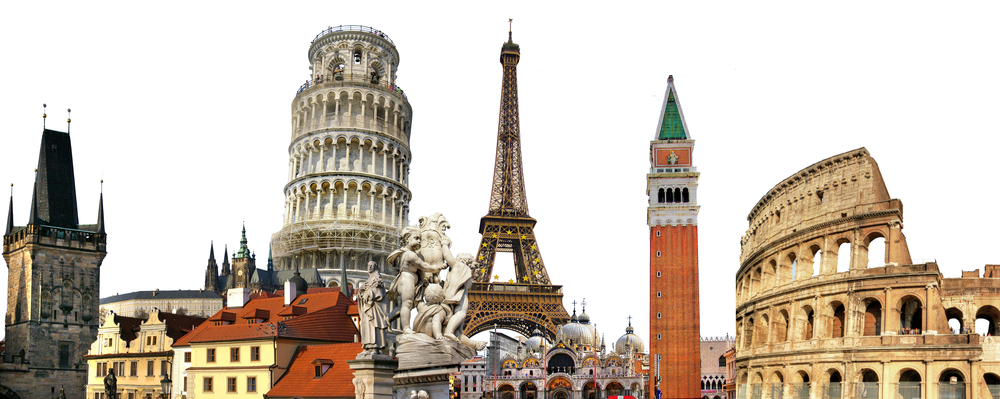About Europe
Europe is the second smallest continent in the world, covering almost one-fifteenth complete land area. The borders of continent on its North have Arctic Ocean, whereas the western frontline has Atlantic Ocean. The southern borders of European landmass have the Kuma-Manych Depression, Caspian Sea, Mediterranean Sea, and the Black Sea. Eastern border of Europe has a boundary touching with the Ural Mountains, extending the South-West Emba (Zhem) River, which later makes entry into the Northern Caspian coast.
Novaya Zemlya, Corsica, Sardinia, Sicily, Malta, Crete, Svalbard, Iceland, the Faroe Islands, the British Isles, the Balearic Islands, Franz Josef Land and Cyprus are the largest islands in Europe. The key peninsular regions forming European continent comprises Scandinavian, Iberian, Italian, and the Balkan. Europe has infinite riches, and above all, there is wide range of diversity seen within.
How Europe Got Its Name:
Europe takes its name from Phoenician princess Europa, who was seduced by the Greek God Zeus, masquerading as nothing else but a bull. According to the legends, Europa climbed on the back of Zeus, who later on whisked her off to the island of Crete. Europe is often times associated with the phrase: “Cradle of Western Culture” for the simple reason that the continent etched the shape of modern world. Europe is also the foremost starting point of industrial revolution, which later spread to other countries of the globe.
About European Cities and Countries:
Europe is known among the richest continents that exist on Earth according to the latest information updates. European population has crossed more than 800 million marks, making it the third most populous continent. Another fascinating thing to find is that Europe does not have any deserts, and it has three time zones - Eastern European Time Zone, Central European Time Zone and Western European Time Zone.
Vatican is the smallest country in Europe, and London has the highest population distribution in Europe. The acme of European continent is the Caucasus Mountains, while the longest river is the Volga.
Iceland, is a completely mosquito free country and travelers don’t have to panic from the dangerous Zika virus attack. Therefore, the country is considered to be the safe haven.
Other References:
The name “Europe” may have descended from the Greek word “Eurus,” which has the connotation of being “Wide” or “Broad”. The name also connotes to ancient Syrian word for sunset called “Ereb.” The first historians to pronounce the word “Europe” (or an ancient variant of the name thereof), referring to geography was Hecataeus and Anaximander. The boundary markings between Asia and Europe have undergone many changes in history. Anaximander and Herodotus considered the borders of Europe near to the Phasis (modern day Rioni) river, while in the golden times of Rome, historians such as Ptolemy and Strabo had European boundaries reaching out to Tanais (modern day Don) river. In the local Turkic language, Europe has earned a yet another title - Frangistan or “the land of the Franks.”
Europe accounts for 11 to 12% of world’s existing population. The historical time period known as “Age of Migrations” has been full of mysteries and intrigues, as during this time, several tribes like the Goths, the Vandals, the Saxons and the Lombards entered European continent and spread their race.
Greatest empires came into existence on European land, and this includes the ancient Roman Empire (the cradle of modern civilization, according to some historians), the British, Spanish, and Russian Empires. The British Empire was the biggest empire, which ruled around one-fourth of the world. You will also be excited to know that the Europe has huge colony of ants, which counts 6,000 kilometers, covering Atlantic coast of Spain and extending the northern part of Italy.
There are over 250 languages spoken in the European land mass. Istanbul the capital of Turkey is the largest city in Europe, if transcontinental nations straddling both Europe and mainland Asia are taken into account. However, on the individual basis, Moscow is considered the biggest, subsequently Paris and later London.
Europe as the continent holds several divisions in the landmass, and many of these European countries have proximity to other continents. Cyprus located near West Asia is European, and Israel also forms an integral part of geopolitical Europe. Greenland on the other hand has close proximity to the North America, is European, and this is for the reason that Greenland has territory united with Denmark.
Transcontinental countries straddled between Asia and Europe includes Georgia, Kazakhstan, Azerbaijan, Russia, and Turkey. If transcontinental countries such as Russia are not taken into account, then Ukraine is Europe’s largest country. Portugal is a tri-continental European country as it has territories in three countries – autonomous region of Madeira, close to Africa, and one more known as Azores, situated in North America.
The popular and among the most visited tourist destination in Europe is not the Eiffel Tower, or the Big Ben, but it happens to be the Disneyland in Paris. Europe’s oldest country is Bulgaria, without the change in its name from 641 AD. Mount Etna, located in Sicilia, Italy, is among the most active volcanoes.
The scheming of separating Europe from Asia (having a common landmass) was the result of the minds of Greeks. The divide was created at Hellespont (today, known as Dardanelles) a strait positioned in the northwestern part of Turkey. The strait is between 1.2 to 6 kms. in width.

